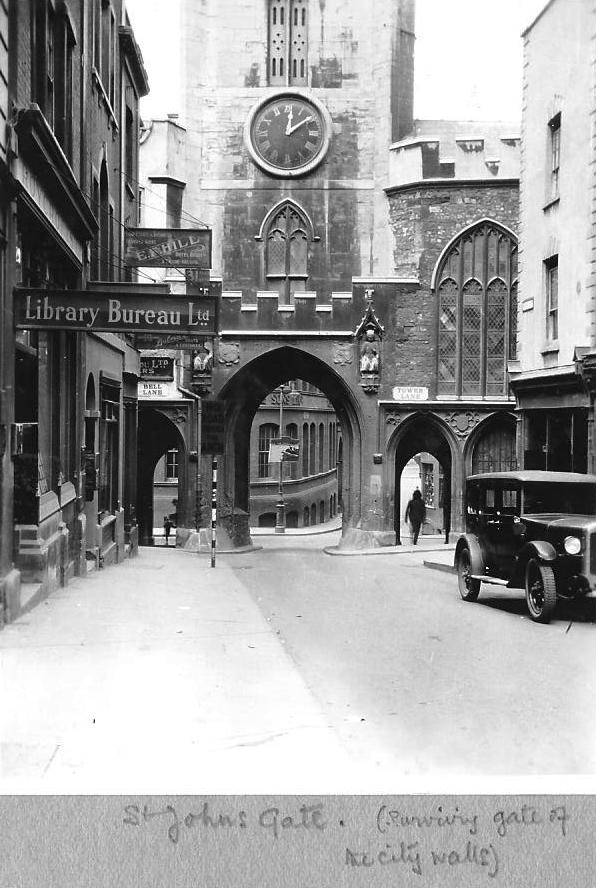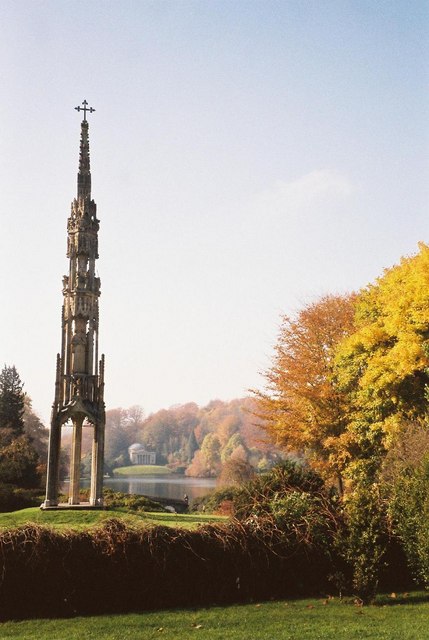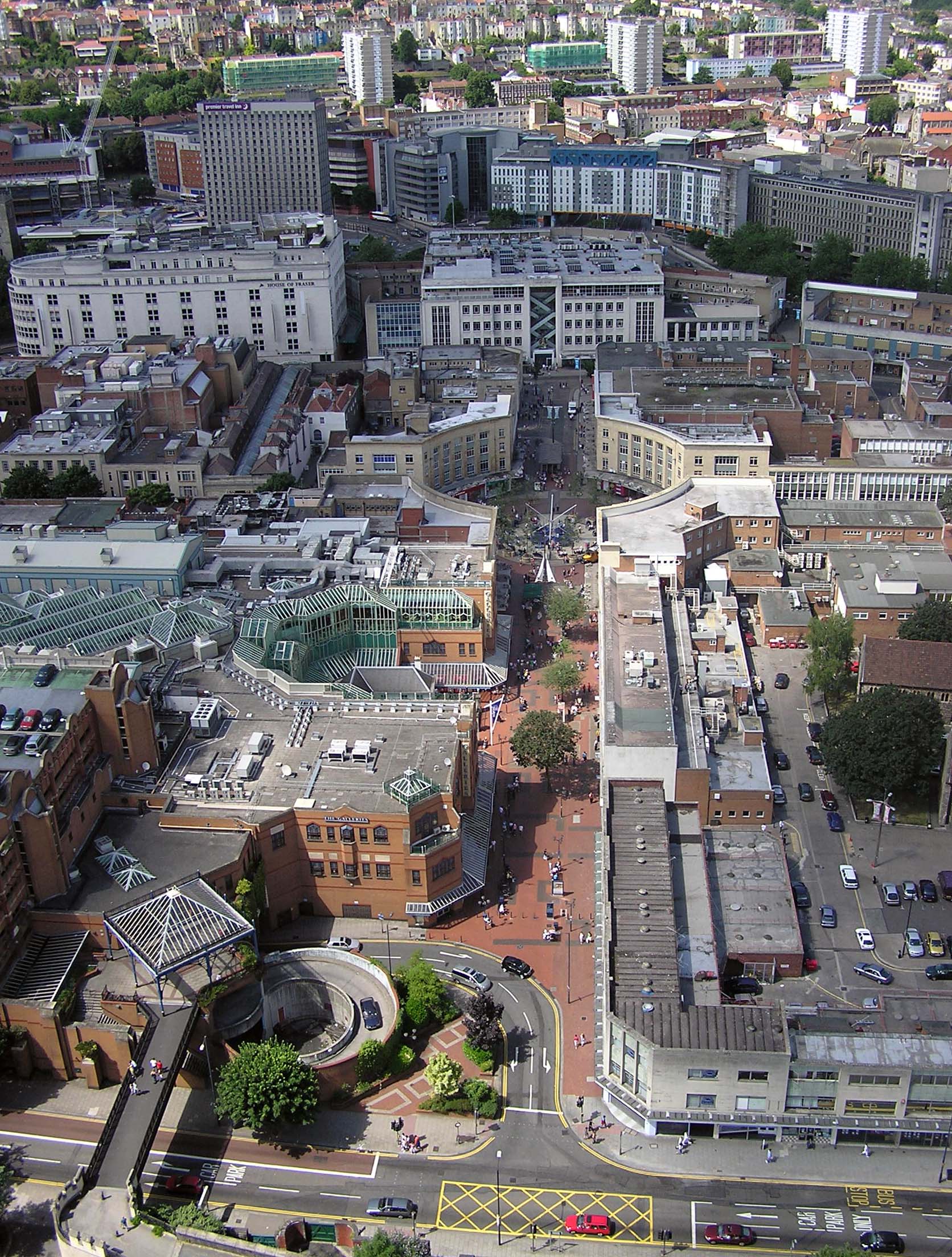|
Bristol City Centre
Bristol City Centre is the commercial, cultural and business centre of Bristol, England. It is the area north of the New Cut of the River Avon, bounded by Clifton Wood and Clifton to the north-west, Kingsdown and Cotham to the north, and St Pauls, Lawrence Hill and St Phillip's Marsh to the east. The Bristol Royal Infirmary, Bristol Royal Hospital for Children, the BBC, the main campus of the University of Bristol, the Crown and Magistrate's Courts, Temple Meads railway station, Bristol bus station, the Park Street, Broadmead and Cabot Circus shopping areas together with numerous music venues, theatres and restaurants are located in this area. The area consists of the council wards of Central, Hotwells & Harbourside, and part of Lawrence Hill. Historic centre The mediaeval heart of the city was immediately north of Bristol Bridge, between the River Frome and the River Avon, at the High Cross where the four cross streets High Street, Wine Street, Broad Stree ... [...More Info...] [...Related Items...] OR: [Wikipedia] [Google] [Baidu] |
Central Business District
A central business district (CBD) is the commercial and business centre of a city. It contains commercial space and offices, and in larger cities will often be described as a financial district. Geographically, it often coincides with the "city centre" or " downtown". However, these concepts are not necessarily synonymous: many cities have a central ''business'' district located away from its commercial and or cultural centre and or downtown/city centre, and there may be multiple CBDs within a single urban area. The CBD will often be characterised by a high degree of accessibility as well as a large variety and concentration of specialised goods and services compared to other parts of the city. For instance, Midtown Manhattan, New York City, is the largest central business district in the city and in the United States. London's city centre is usually regarded as encompassing the historic City of London and the medieval City of Westminster, while the City of London and the trans ... [...More Info...] [...Related Items...] OR: [Wikipedia] [Google] [Baidu] |
Bristol Crown Court
The Bristol Crown Court is a Crown Court venue in Bristol, England. It is located at the Law Courts in Small Street. Until 1993 the Crown Court met in the Guildhall, on the opposite side of the road. The new Crown Court, which has ten courtrooms, was created by converting the old Post office between 1989 and December 1993. Archives Records of the Bristol Courts of Assizes and the Quarter Sessions, which preceded the Crown Court, are held at Bristol Archives (Ref. JQS)online catalogue. Bristol Crown Court records from 1972 onwards are held at the National Archives UK , type = Non-ministerial department , seal = , nativename = , logo = Logo_of_The_National_Archives_of_the_United_Kingdom.svg , logo_width = 150px , logo_caption = , formed = , preceding1 = , dissolved = , superseding = , juris .... References External linksCourt information Crown Court buildings Grade II* listed buildings in Bristol Court buildings in England {{England-law-stub ... [...More Info...] [...Related Items...] OR: [Wikipedia] [Google] [Baidu] |
Saxon
The Saxons ( la, Saxones, german: Sachsen, ang, Seaxan, osx, Sahson, nds, Sassen, nl, Saksen) were a group of Germanic * * * * peoples whose name was given in the early Middle Ages to a large country (Old Saxony, la, Saxonia) near the North Sea coast of northern Germania, in what is now Germany. In the late Roman Empire, the name was used to refer to Germanic coastal raiders, and as a name similar to the later "Viking". Their origins are believed to be in or near the German North Sea coast where they appear later, in Carolingian times. In Merovingian times, continental Saxons had been associated with the activity and settlements on the coast of what later became Normandy. Their precise origins are uncertain, and they are sometimes described as fighting inland, coming into conflict with the Franks and Thuringians. There is possibly a single classical reference to a smaller homeland of an early Saxon tribe, but its interpretation is disputed. According to this proposal, the ... [...More Info...] [...Related Items...] OR: [Wikipedia] [Google] [Baidu] |
Corn Street, Bristol
Corn Street, together with Broad Street, Wine Street and High Street, is one of the four cross streets which met at the Bristol High Cross, the heart of Bristol, England when it was a walled medieval town. From this crossroads Corn Street and its later extension ''Clare Street'' runs downhill approximately 325m south-westwards to The Centre. Corn Street contains many historic buildings. For centuries it was at the centre of Bristol's commerce and administration, but in recent years has increasingly turned to market shopping, leisure and accommodation. History Corn Street, together with Broad Street, Wine Street and High Street, formed the earliest nucleus of Bristol. Ricart's Plan of 1479, one of the first English town plans, shows Corn Street with the High Cross at one end and St Leonard's Gate at the other. The other three cross streets are also shown, each ending at their own gate in the city wall. The origins of the name ''Corn Street'' are uncertain, but the simple ... [...More Info...] [...Related Items...] OR: [Wikipedia] [Google] [Baidu] |
Broad Street, Bristol
Broad Street, along with High Street, Wine Street and Corn Street, is one of the four original streets that have made up the city of Bristol since Saxon times, when it was the burgh of ''Brycgstow''. Prior to the building of The Exchange merchants would set up their stalls on Broad Street. An old city gate stands at the bottom of the street, where it joins Quay Street. Notable architecture Going downhill from the junction with Corn Street, other notable buildings include Christ Church with St Ewen, designed and built by William Paty in the late 18th century, a former branch of the Bank of England designed by Charles R Cockerell in Greek Doric style, the Thistle Hotel, Bristol by Foster and Wood in Italian Renaissance, the Guildhall in Gothic style by Richard Shackleton Pope and the Art Nouveau Edward Everard printing works. The printing works features a mural designed by W J Neatby depicting Gutenberg and William Morris, the founders of modern printing; a woman h ... [...More Info...] [...Related Items...] OR: [Wikipedia] [Google] [Baidu] |
Wine Street, Bristol
Wine Street, together with High Street, Broad Street and Corn Street, is one of the four cross streets which met at the Bristol High Cross, the heart of Bristol, England when it was a walled mediaeval town. From this crossroads Wine Street runs along a level ridge approximately 175m north-eastwards to the top of Union Street. Wine Street was for centuries an important shopping street but, following wartime destruction and the decision to move Bristol's main shopping area to Broadmead, it now contains little notable architecture and acts as barrier between the Old City and Castle Park. Bristol City Council are now seeking to repair this by redeveloping the area. History Wine Street, together with High Street, Corn Street and Broad Street, formed the earliest nucleus of Bristol. Ricart's Plan of 1479, one of the first English town plans, shows Wine Street with the High Cross at one end and Newgate at the other; the other three cross streets are also shown, each ending at the ... [...More Info...] [...Related Items...] OR: [Wikipedia] [Google] [Baidu] |
High Street, Bristol
High Street, together with Wine Street, Broad Street and Corn Street, is one of the four cross streets which met at the carfax, later the site of the Bristol High Cross, the heart of Bristol, England when it was a walled medieval town. From this crossroads High Street runs downhill south-east to Bristol Bridge, a distance of approximately 155m. Once an important shopping street, wartime destruction and post-war planning have left High Street shabby and a constraint on pedestrian movement between the Old City and Castle Park. Bristol City Council are now seeking to redevelop the area to repair this. History High Street, together with Corn Street, Broad Street and Wine Street, formed the earliest nucleus of Bristol. It is shown clearly on Ricart's Plan, one of the first English town plans, with the High Cross at its top and St Nicholas Church (which then incorporated the town's southern gate) at its foot. The street appears to have changed little by the time Millerd's ''Ci ... [...More Info...] [...Related Items...] OR: [Wikipedia] [Google] [Baidu] |
Bristol High Cross
Bristol High Cross is a monumental market cross erected in 1373 in the centre of Bristol. It was built in Decorated Gothic style on the site of an earlier Anglo-Saxon cross, to commemorate the granting of a charter by Edward III to make Bristol a county, separate from Somerset and Gloucestershire. In 1764 it was moved to the Stourhead estate in Wiltshire, where it still stands. Construction The cross stood in the centre of the town, at the crossroads of its four main streets (). After it was enlarged in 1663, it was in four tiers. The base was four octagonal piers with cusped ogee arches. The next two tiers contained alcoves with statues of English monarchs. The top tier was a pinnacle with the actual cross as a finial. The material was oolitic limestone but, as this was susceptible to frost damage, this was subsequently painted in colours of blue, gold, red and vermilion. The vermilion was the predominant colour of the statues, being used for their dresses, and aged w ... [...More Info...] [...Related Items...] OR: [Wikipedia] [Google] [Baidu] |
River Frome, Bristol
The Frome , historically the Froom, is a river that rises in Dodington Park, South Gloucestershire, and flows southwesterly through Bristol to join the river Avon. It is approximately long, and the mean flow at Frenchay is . The name ''Frome'' is shared with several other rivers in South West England and means 'fair, fine, brisk'. The river is known locally in east Bristol as the ''Danny''. As with many urban rivers, the Frome has suffered from pollution, but several stretches run through parks and reserves that sustain a range of wildlife. The river's power was harnessed by many watermills, and the river mouth area was developed as shipyards by the eighteenth century. As the city of Bristol developed in the nineteenth and twentieth centuries, flooding became a major problem, remedied by the construction of storm drains and diversions. Etymology The river's name derives from the British Celtic, meaning 'fair, fine, brisk’. It is not to be confused with other rivers ... [...More Info...] [...Related Items...] OR: [Wikipedia] [Google] [Baidu] |
Bristol Bridge
Bristol Bridge is a bridge over the floating harbour in Bristol, England. The floating harbour was constructed on the original course of the River Avon, and there has been a bridge on the site since long before the harbour was created by impounding the river in 1809. The current bridge was completed in 1768 and is a Grade II listed building. Bristol Bridge is the furthest downstream of the fixed bridges across the harbour, and marks the limit of navigation for any vessel that is unable to pass beneath its arches. Downstream from the bridge the harbour is lined by wharves and warehouses, with Welsh Back to the west and Redcliffe Back to the east. Upstream, the land to the west is occupied by Castle Park, created on an area destroyed by bombing during the second world war, whilst the opposite bank is occupied by the former Georges Bristol Brewery, now redeveloped as Finzels Reach. History Bristol's name is derived from the Saxon ''Brycgstow'' or 'Brigstowe', meaning the 'pl ... [...More Info...] [...Related Items...] OR: [Wikipedia] [Google] [Baidu] |
Cabot Circus
Cabot Circus is a covered shopping centre in Bristol, England. It is adjacent to Broadmead, a shopping district in Bristol city centre. The Cabot Circus development area contains shops, offices, a cinema, hotel and 250 apartments. It covers a total of floor space, of which is retail outlets and leisure facilities. It opened in September 2008, after a ten-year planning and building project costing £500 million. History Site Before the building of Cabot Circus the site contained post-war shopping units and part of the A4044 Bristol inner ring road. Tollgate House and its car park were also demolished, for the re-aligned part of the ring road and the Cabot Circus car park. Many old streets were wiped off the map, although these had long been devoid of their houses. The original chosen name 'Merchants Quarter' came under criticism due to its associations to the slave trade. The name of Cabot was chosen following a public vote taken in November 2007, and commemorates John Cabot, ... [...More Info...] [...Related Items...] OR: [Wikipedia] [Google] [Baidu] |
Broadmead
Broadmead is a street in the central area of Bristol, England, which has given its name to the principal shopping district of the city. It is part of Bristol Shopping Quarter. History The name of the street was first recorded in 1383 as ''Brodemede''. The name either means "broad meadow" or refers to ''brodemedes'', a type of woollen cloth woven only in Bristol. The area lay just to the north of the town walls of the historic Bristol. In about 1227 Blackfriars was founded as a Dominican priory in the area. After the dissolution of the monasteries the site had various secular uses, and in 1749 became the location of a Quaker meeting house, now known as Quakers Friars. In 1671 local dissenters opened the Broadmead Baptist Chapel near the junction of Broadmead and Union Street. In 1739 John Wesley built his Methodist chapel, known as the New Room, in the street. Shops were also built in the area. In the 18th century a covered arcade was built between Horsefair and Br ... [...More Info...] [...Related Items...] OR: [Wikipedia] [Google] [Baidu] |
.jpg)







